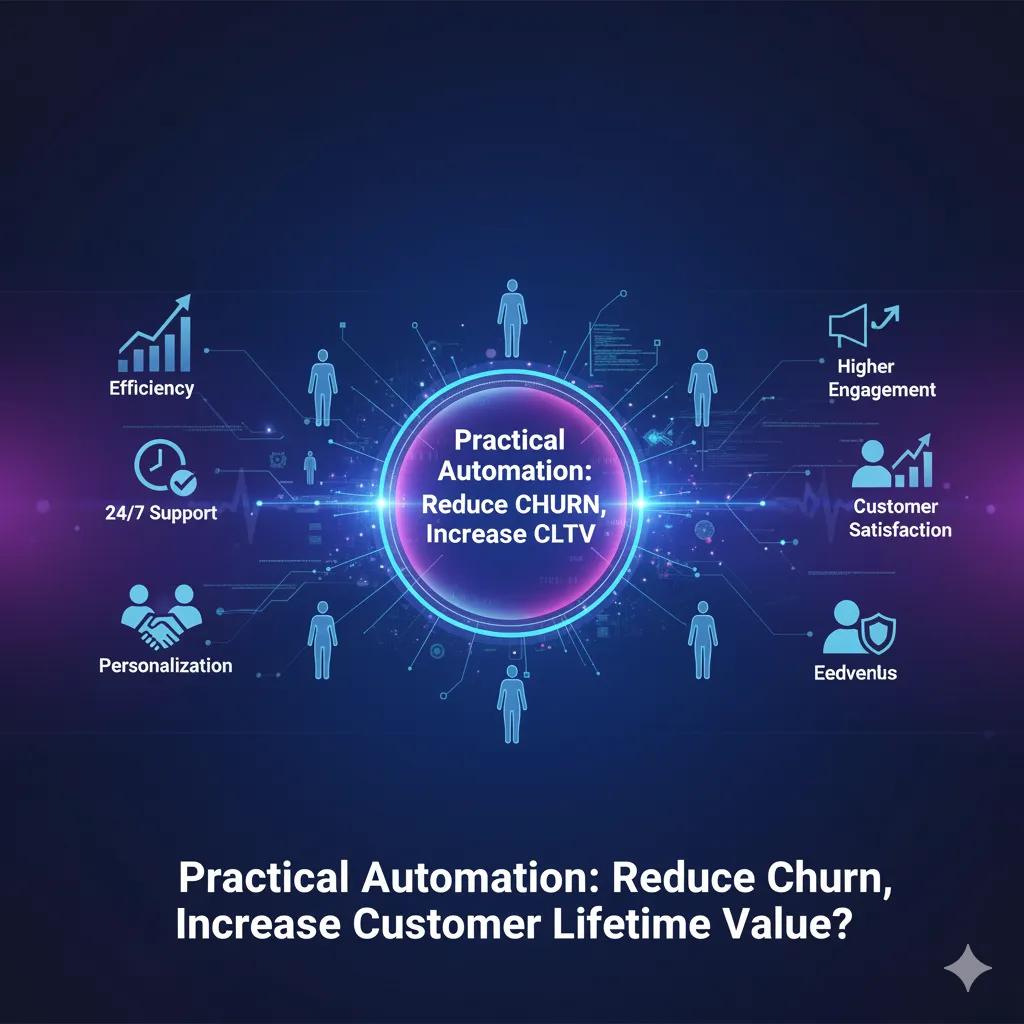
How practical voice automation can reduce churn and increase customer lifetime value?

Voice AI describes conversational voice systems that combine speech recognition, natural language processing (NLP), and dialogue management to handle customer calls with human-like understanding at scale. This guide shows how Voice AI strengthens retention through context-aware conversations, proactive outreach, and reliable 24/7 support: reducing friction, lifting lifetime value, and building loyalty. You’ll get a clear look at the mechanisms that drive retention, the features that deliver measurable outcomes, operational and integration best practices, ethical safeguards that protect trust, and industry use cases. The guide also maps practical CRM integration patterns and includes checklists to make deployment and ROI conversations straightforward for non-technical leaders. Throughout, we focus on Voice AI tactics for lowering churn and improving CLTV, with selective references to The Power Labs’ AI Voice Bot as a solution option.
What is customer lifetime value using AI? How Does Voice AI Enhance Customer Retention and Loyalty?
The Customer Lifetime Value Model is a predictive analytics tool in the AI Workbench. It uses historical customer data to understand patterns and predict the likelihood of a customer, or a group of customers, improving their engagement with your products or services. Voice AI improves retention by combining speech intelligence with customer context to remove friction and deliver timely, personalized touches that keep customers engaged. It relies on NLP-powered intent recognition, conversational memory that keeps context across sessions, and automation that supports proactive outreach—think renewal reminders and check-ins. The outcome is faster resolution, fewer missed opportunities, consistent follow-up, and a more emotionally resonant experience that strengthens loyalty. Below are the core mechanisms that make Voice AI effective at keeping customers.
Voice AI improves retention through three principal mechanisms:
Personalization: Context-aware conversations reference customer history to tailor support and offers during calls or callbacks.
Proactive outreach: Timed reminders and renewal prompts re-engage customers before they churn.
24/7 availability: Immediate voice responses outside business hours prevent abandonment and resolve urgent issues.
These mechanisms convert into concrete benefits for loyalty programs, subscription renewals, and repeat engagement. Understanding each mechanism guides targeted feature choices and integration steps in the following sections. For teams ready to pilot these tactics, The Power Labs’ AI Voice Bot offers a pragmatic bridge delivering NLP, context-aware interactions, and always-on support while helping prospects understand the operational and commercial benefits of voice automation.
What Role Does AI Voice Bot Play in Reducing Customer Churn?
An AI Voice Bot curbs churn by spotting early warning signals, automating retention plays, and handing off to human agents when a conversation needs empathy or negotiation. Early detection relies on markers like shifts in call intent, repeated contacts, or negative sentiment. Those signals can trigger automated retention actions—targeted discounts, personalized onboarding calls, or renewal nudges to re-engage customers. When the situation requires human intervention, a smooth handoff preserves context so agents resolve issues quickly and prevent churn.
Preserving context and enabling seamless escalation matters because customers expect fast, coherent service across channels.
How Does Personalized Voice AI Improve Customer Engagement?

Personalized Voice AI raises engagement by combining CRM history, real-time signals, and conversational memory to create dialogues that feel relevant and efficient. When the voice system refers to recent orders, open tickets, or loyalty status, customers perceive competence and relevance boosting CSAT and repeat interactions. Enriching CRM records with voice transcripts lets the system surface timely offers or recovery actions based on individual behavior. Privacy-first data handling and clear consent prompts preserve trust while enabling the kind of personalization that drives repeat business.
This customer-first personalization also creates natural upsell and cross-sell moments, timely and respectful that move relationships from one-off transactions to ongoing loyalty, which is essential for long-term retention.
What Are the Key Features and Benefits of The Power Labs AI Voice Bot for Customer Retention?
The Power Labs AI Voice Bot packages conversational AI features tuned to reduce churn and grow lifetime value through context preservation, accurate NLP, and automated outreach. Key capabilities include intent recognition, entity extraction, dialogue state management, optional voice biometrics, proactive campaign scheduling, and CRM API connectors for enrichment. Together, these features shorten resolution times, surface at-risk customers, and automate timely retention plays without losing the human touch when it matters.
Key features and one-line benefit statements:
NLP-driven intent recognition: Fewer misroutes: customers reach the right flow faster.
Context-aware dialogue management: Keeps conversation history so customers don’t repeat themselves.
24/7 automated voice support: Captures after-hours issues and follow-up opportunities.
Lead identification and enrichment: Turns voice interactions into CRM-ready leads and profile updates.
Seamless human handoff: Escalates complex cases with full context for better outcomes.
If you’d like to see how they apply to your business, The Power Labs offers demos and briefings to translate capability into measurable outcomes and next steps.
How Does Natural Language Processing Enable Context-Aware Customer Interactions?
Natural Language Processing (NLP) powers context-aware interactions by identifying intent, extracting entities (like account numbers or product names), and maintaining dialogue state across exchanges. Intent detection reduces misroutes and shortens call flows, while entity extraction pre-fills fields and speeds resolution. Context management lets follow-ups pick up where the prior conversation left off, avoiding repetitive questions and lowering customer effort. Together, these NLP elements turn voice signals into CRM events and personalized responses that increase satisfaction and loyalty.
When NLP links tightly to customer data, every interaction becomes an opportunity to enrich profiles and trigger targeted retention workflows: an idea we expand on in the always-on support section.
What Are the Advantages of 24/7 Automated Voice Support for Customer Loyalty?
Round-the-clock automated voice support closes coverage gaps and prevents abandonment for time-sensitive issues like billing disputes or fraud alerts. Being available outside normal hours reduces customer frustration and signals reliability across time zones. Scheduled callbacks and automated follow-ups capture renewal and sales opportunities that would otherwise be missed, improving overall retention. Consistent messaging and compliance-ready scripts protect brand reputation while letting teams handle volume without linear staff increases.
These benefits make 24/7 voice support a core retention lever for global businesses and subscription models, and they pair well with multi-bot strategies that coordinate voice, chat, lead gen, and operations automation.
How Can AI Automation with Voice Bots Reduce Operational Costs and Improve Customer Service?
When implemented correctly, voice-bot automation lowers operational costs by handling repetitive tasks, reducing average handle time (AHT), and cutting the number of routine contacts that reach expensive human agents. Automating verification, FAQ responses, appointment scheduling, and follow-ups frees agents for higher-value work and eases staffing pressure. Proactive outbound voice campaigns also capture renewals and upsell opportunities that grow revenue without adding commensurate support costs. The combined effect is higher CSAT on a leaner cost base, letting teams reinvest savings into better experiences.
Automated verification: Speeds identity checks and shortens call flows.
Self-service FAQs & transactions: Reduces routine call volume and repeat contacts.
Proactive outbound campaigns: Drives renewals and retention touches with minimal live-agent time.
Automating routine voice tasks converts manual effort into scalable workflows, cutting cost per contact and creating capacity for strategic service work.
In What Ways Does AI Voice Bot Streamline Manual Tasks and Increase Revenue?
AI Voice Bots automate verifications, form-filling, appointment scheduling, and basic troubleshooting, reducing agent cognitive load and lowering average handling time. Offloading these tasks lets human teams focus on complex retention conversations and conversion moments. Real-time qualification and intelligent lead routing during calls turn in-call signals into sales opportunities, raising conversion efficiency without adding headcount. The net result is lower operating cost, faster service, and incremental revenue from reactivated or upsold customers.
Tying these automation gains back to retention, proactive voice outreach captures revenue moments at the right time and strengthens customer relationships rather than just servicing them.
How Does AI-Driven Proactive Engagement Boost Customer Lifetime Value?
AI-driven proactive engagement raises CLTV by spotting risk or opportunity windows and delivering targeted voice interactions that re-engage customers before they churn. Tactics like renewal reminders, usage-based offers, and satisfaction check-ins keep customers connected and informed. When interventions are timed and contextual; driven by CRM signals and recent activity, response rates improve and purchases follow. Over time, repeated, well-timed touches compound into stronger relationships and higher lifetime value through improved retention and incremental sales.
This approach runs on a repeatable framework: detect, engage, measure- that ties voice interactions directly to retention KPIs and revenue attribution.
Why Is Ethical AI Important in Voice AI Solutions for Building Customer Trust and Retention?

Ethical AI matters because trust is the foundation of retention. Transparent, fair, and privacy-respecting voice interactions reduce friction and protect your brand. Responsible practices—disclosing automated interactions, managing consent for data use, and keeping humans in the loop for edge cases produce predictable, auditable experiences customers can trust. When people feel their data is handled with care and interactions are explainable, they’re more likely to engage and remain loyal. Designing ethical guards into Voice AI is therefore a retention strategy, not just a compliance item.
Transparency: Tell callers when they’re speaking to AI and offer easy escalation to a human.
Consent & data minimization: Collect only what’s needed and get clear consent for recording or profiling.
Human oversight: Keep people in the loop for disputed or sensitive interactions.
Adopting these practices reduces reputational risk and strengthens customers’ willingness to stay, exactly the outcome retention programs must deliver.
How Does The Power Labs Ensure Transparent and Secure AI Customer Interactions?
The Power Labs embeds responsible AI principles and human oversight into its product design. Practical controls include clear disclosure when interactions are automated, configurable opt-out and escalation flows, and human review for high-stakes conversations. These controls follow privacy and explainability best practices so organizations can scale voice automation without sacrificing trust. Treating ethical safeguards as part of deployment rather than optional extras helps businesses avoid reputational risk while capturing the retention benefits of voice automation.
Built-in ethical measures also support compliance and customer confidence, which in turn help protect retention and lifetime value.
What Impact Does Ethical AI Have on Customer Satisfaction and Loyalty?
Ethical AI improves satisfaction and loyalty by removing surprises and ensuring customers feel respected and in control of their data. When voice systems are upfront about what they can and can’t do, customers are less likely to feel misled, boosting CSAT and lowering churn triggers. Privacy-preserving personalization balances relevance with discretion, enabling tailored experiences without eroding trust. The result is a more durable relationship where capability and integrity both support satisfaction.
Trust-based retention is especially important in industries that handle sensitive data, where customer confidence directly affects renewals and long-term CLTV.
How Do You Integrate Voice AI with CRM Systems to Enhance Customer Journeys?
Voice AI integrates with CRMs through a simple data flow: voice bot captures interaction data → NLP extracts intents and entities → the system pushes structured events to the CRM via APIs or webhooks → automation triggers follow-ups and profile updates. This pattern enables real-time personalization, event-driven outreach, and a unified customer view so each interaction becomes more relevant. Key technical patterns include RESTful APIs for enrichment, webhooks for immediate eventing, and middleware for orchestration and error handling. Robust monitoring and fallback logic keep voice interactions reliable and valuable for retention workflows.
Below are integration best practices to guide deployment.
Pilot and scope: Start with a narrow use case and a controlled segment to validate flows.
Use webhooks/APIs: Send structured voice events to CRM for real-time updates and automation triggers.
Preserve context: Store dialogue state and transcripts linked to CRM records for future personalization.
Monitor and iterate: Track KPIs like resolution time, handoff rates, and campaign outcomes to refine flows.
Plan escalation paths: Ensure smooth transfer to human agents with full context when required.
Effective CRM integration turns voice interactions into persistent, actionable data that fuels personalized retention plays and makes measurement straightforward.
What Are Best Practices for Deploying AI Voice Bots in Existing Customer Service Platforms?
A practical deployment checklist includes piloting in a focused segment, validating CRM and contact center integrations, setting monitoring and KPIs, training agents for smooth handoffs, and iterating based on real-world data. Define success criteria, reduced AHT or increased retention touches and run pilots long enough to collect representative metrics. Monitor for failed handoffs and sample conversations to refine NLP models. Training agents on handoff procedures preserves context and reduces customer effort, while staged rollouts let teams scale with confidence.
How Does CRM Integration Amplify the Effectiveness of Voice AI for Retention?
CRM integration amplifies Voice AI by enabling event-driven personalization and automated follow-ups that are timed and targeted from a unified customer profile. When voice events update CRM records in real time, the system can trigger retention workflows tailored offers or proactive outreach based on the latest signals. A unified view reduces repetitive contacts and supports coordinated cross-channel campaigns that reinforce loyalty. The result: a customer journey where each touchpoint builds on the last, driving renewals and advocacy.
Treating voice interactions as first-class CRM events turns conversations into measurable retention levers and ties voice automation directly to CLTV improvements.
What Are Real-World Success Stories Demonstrating Voice AI’s Impact on Customer Retention?
Real-world Voice AI implementations tend to follow a pattern: identify high-friction retention moments, deploy a targeted voice flow or campaign, measure impact on recovery or renewal, and iterate. Case stories focus on mechanisms—proactive outreach, context preservation, and human handoffs, rather than vendor hype, and they show measurable results like higher reactivation rates and improved satisfaction. Across industries, organizations that integrate Voice AI thoughtfully with CRM and operations report similar retention gains.
Subscription services: Problem: missed renewals; Solution: automated voice renewal prompts with human fallback; Outcome: higher renewal capture and lower churn signals.
Retail post-purchase: Problem: unresolved post-purchase issues cause returns; Solution: 24/7 voice follow-ups and triage; Outcome: more repeat purchases and fewer returns.
Healthcare reminders: Problem: missed appointments and low adherence; Solution: personalized voice reminders tied to patient records; Outcome: better adherence and higher patient satisfaction.
These vignettes illustrate how voice-driven interventions improve retention across use cases. For teams wanting tailored ROI estimates or demos, The Power Labs provides applied demonstrations that map Voice AI features to your KPIs—contact us to explore how these approaches fit your metrics and workflows.
How Have Businesses Reduced Churn Using The Power Labs AI Voice Bot?
Organizations cut churn with The Power Labs AI Voice Bot by implementing targeted retention flows, proactive outreach, and seamless escalation to humans when needed. The product uses NLP and context-aware interactions to identify at-risk customers during routine calls and trigger tailored interventions, personalized offers or account reviews that re-engage customers before they churn. Converting voice interactions into CRM events and enrichment data creates continuous learning loops that improve future retention plays. Together, these mechanisms produce measurable improvements in renewals and customer satisfaction across deployments.
These anonymized narratives show how the product’s capabilities map to retention mechanics without disclosing client metrics, demonstrating a repeatable approach to reducing churn through voice automation.
What Industry-Specific Use Cases Highlight Voice AI’s Role in Customer Loyalty?
Voice AI supports industry-specific loyalty plays by addressing domain pain points with tailored scripts and integrations. In healthcare, voice reminders and post-visit follow-ups boost adherence and satisfaction. In finance, voice workflows handle renewals, fraud alerts, and high-touch compliance interactions that preserve trust. In retail, post-purchase support and loyalty engagement by voice cut returns and encourage repeat buying. Public sector and service organizations use voice outreach to maintain civic engagement and timely compliance, improving satisfaction with public services.
These use cases show Voice AI’s core strengths: personalization, timeliness, and smooth human escalation, translate across verticals and produce retention outcomes aligned with each sector’s expectations and regulations.
AI for 24/7 Customer Service: Personalization, Insights, and Ethical Considerations The growing use of AI by service providers supports 24/7 customer coverage, helps educate and empower consumers, and enables teams to gather deeper insights and streamline communication. At the same time, AI in support raises ethics and privacy questions. Human intervention at key points in the customer journey remains important for building and maintaining relationships. Thoughtful use of AI paired with ethical safeguards creates better service experiences for customers.
Frequently Asked Questions
What are the main challenges businesses face when implementing Voice AI for customer retention?
Common challenges include integrating Voice AI cleanly with existing CRMs to avoid data silos, training models to handle diverse accents and dialects, addressing privacy and compliance requirements, and finding the right balance between automation and human support. Getting these elements right is essential to deliver effective, trusted retention experiences.
How can businesses measure the effectiveness of Voice AI in improving customer loyalty?
Measure Voice AI impact with KPIs like customer satisfaction (CSAT), net promoter score (NPS), and retention rates. Operational metrics AHT, first-contact resolution, and handoff success also signal efficiency gains. Track campaign-specific outcomes (renewal captures, reactivations) and combine quantitative metrics with qualitative feedback to evaluate loyalty impact.
What ethical considerations should companies keep in mind when deploying Voice AI?
Key ethical considerations are transparency (disclose automated interactions), consent and data minimization (collect only what’s needed), and human oversight for sensitive cases. Embedding these principles into design helps preserve trust and reduces reputational risk while enabling useful personalization.
How does Voice AI handle customer data privacy and security?
Voice AI platforms protect data through encryption in transit and at rest, and by following applicable regulations such as GDPR or CCPA. Best practices include obtaining explicit consent for recordings and profiling, regular access audits, and robust monitoring to detect and respond to breaches. Prioritizing privacy helps maintain customer trust.
What industries can benefit the most from Voice AI technology?
Industries with high customer interaction volumes benefit strongly: healthcare (appointment reminders, follow-ups), finance (renewals, fraud alerts, compliance), retail (post-purchase support, loyalty engagement), and public services (outreach and compliance reminders). In short, any sector focused on customer engagement and retention can gain from Voice AI.
What future trends can we expect in Voice AI technology for customer retention?
Expect deeper personalization and smoother integration across AI systems. As NLP improves, Voice AI will better understand context and sentiment, enabling more meaningful conversations. Predictive analytics will let teams anticipate customer needs and act proactively. Ethical AI practices and explainability will also rise in importance as adoption grows.
Conclusion
Voice AI can materially improve customer retention by delivering personalized, proactive, and context-aware interactions that foster loyalty. Built-in ethical practices keep customer trust intact; vital for long-term relationships. When paired with strong CRM integration and operational discipline, voice automation streamlines service and drives higher lifetime value. Learn how The Power Labs’ AI Voice Bot can strengthen your customer engagement and retention strategy reach out for a demo or consultation.